
Bauhinia is a large genus of flowering plants in the subfamily Cercidoideae and tribe Bauhinieae, in the large flowering plant family Fabaceae, with a pantropical distribution. The genus was named after the Bauhin brothers Gaspard and Johann, Swiss-French botanists.

Bauhinia × blakeana, commonly called the Hong Kong orchid tree, is a hybrid leguminous tree of the genus Bauhinia. It has large thick leaves and striking purplish red flowers. The fragrant, orchid-like flowers are usually 10 to 15 centimetres across, and bloom from early November to the end of March. Although now cultivated in many areas, it originated in Hong Kong in 1880 and apparently all of the cultivated trees derive from one cultivated at the Hong Kong Botanical Gardens and widely planted in Hong Kong starting in 1914. It is referred to as bauhinia in non-scientific literature though this is the name of the genus. It is sometimes called the Hong Kong orchid. In Hong Kong, it is most commonly referred to by its Chinese name of 洋紫荊 (yèuhng jígīng).
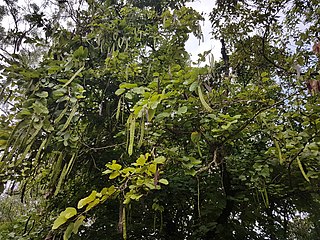
Bauhinia purpurea is a species of flowering plant in the family Fabaceae, native to the Indian subcontinent and Myanmar, and widely introduced elsewhere in tropical and subtropical areas of the world. Common names include orchid tree, purple bauhinia, camel's foot, butterfly tree, and Hawaiian orchid tree.
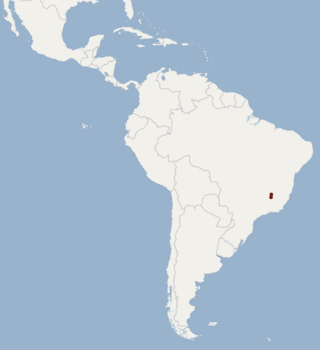
Bokermann's nectar bat is a bat species from South America. It is endemic to Brazil. It feeds on nectar, and is listed as an endangered species.

Dekeyser's nectar bat is a bat species found in Brazil and Bolivia.
Bauhinia augusti is a species of plant in the family Fabaceae. It is found only in Peru.

Bauhinia bowkeri is a species of legume in the family Fabaceae. It is a scrambling shrub or small tree found only in South Africa, where it is threatened by habitat loss.
Bauhinia haughtii is a species of plant in the family Fabaceae. It is found only in Ecuador. Its natural habitats are subtropical or tropical moist lowland forests and subtropical or tropical moist montane forests.
Bauhinia integerrima is a species of plant in the family Fabaceae, in Brazil. The plant is endemic to southern Bahia state, in the Atlantic Forest ecoregion of Southeast Brazil.
Bauhinia mombassae is a species of plant in the family Fabaceae. It is found in Kenya and Tanzania. It is threatened by habitat loss.
Bauhinia seleriana is a species of plant in the family Fabaceae. It is found from central and southern Mexico to Honduras.
Bauhinia pichinchensis is a species of plant in the family Fabaceae. It grows as a tree reaching 10 m in height. It is found only in Ecuador. Its natural habitats are subtropical or tropical moist lowland forests and subtropical or tropical moist montane forests.
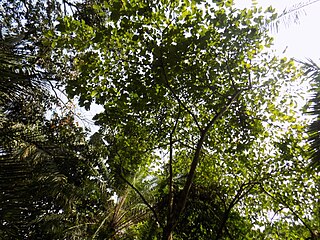
Bauhinia picta, known as the algodoncillo, casco de vaca, palo de orquídeas, or pata de vaca, is a species of plant in the family Fabaceae. It is found in Colombia, México, Panama, and Venezuela.
Bauhinia seminarioi is a species of plant in the family Fabaceae. It is found only in Ecuador. Its natural habitat is subtropical or tropical dry forests.
Bauhinia stenantha is a species of plant in the family Fabaceae. It is found only in Ecuador. Its natural habitat is subtropical or tropical dry shrubland.
Brenierea insignis is a species of flowering plants in the legume family, Fabaceae. It belongs to the subfamily Cercidoideae and is the only member of the genus Brenierea. It is endemic to Madagascar.
Berlinia korupensis is a species of tree up to 42 m tall and 88 cm in diameter, belonging to the Senna subfamily Caesalpinioideae of the Bean Family, and is endemic to the Korup National Park in Cameroon, West Africa. Having produced large, delicate white flowers remindful of Bauhinia, the species' seed pods can grow to be 30 cm long. Seed dispersal is explosive with the opposing halves of the pods tightening as they dry until suddenly they split and shoot seeds for a distance that can be as great as 50 metres. It is on the Critically Endangered list as thus far only 17 trees have been found. This is a very recent discovery, having been unknown to the outside world prior to June of 2010.
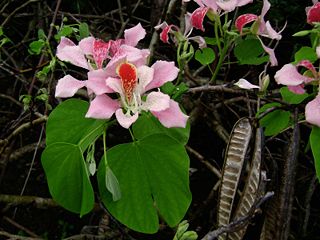
Bauhinia monandra is a species of leguminous trees, of the family Fabaceae. Common names include pink bauhinia, orchid tree, and Napoleon's plume. The tree is native to Madagascar, where it is widespread in lowland humid forests and dry forests. It has naturalised in Myanmar, Australia, Christmas Island, the Caribbean, southern USA, Colombia, Brazil, and the Pacific Islands. The species is invasive in New Caledonia.
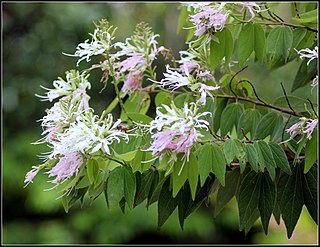
Bauhinia divaricata, the bull hoof or Mexican orchid tree, is a species of flowering plant in the family Fabaceae. It is native to Mexico, Central America, and the Caribbean.

Lysiphyllum cunninghamii is a species of plant in the family Fabaceae. It is native to northern Australia where it occurs from Western Australia through the Northern Territory to Queensland.










